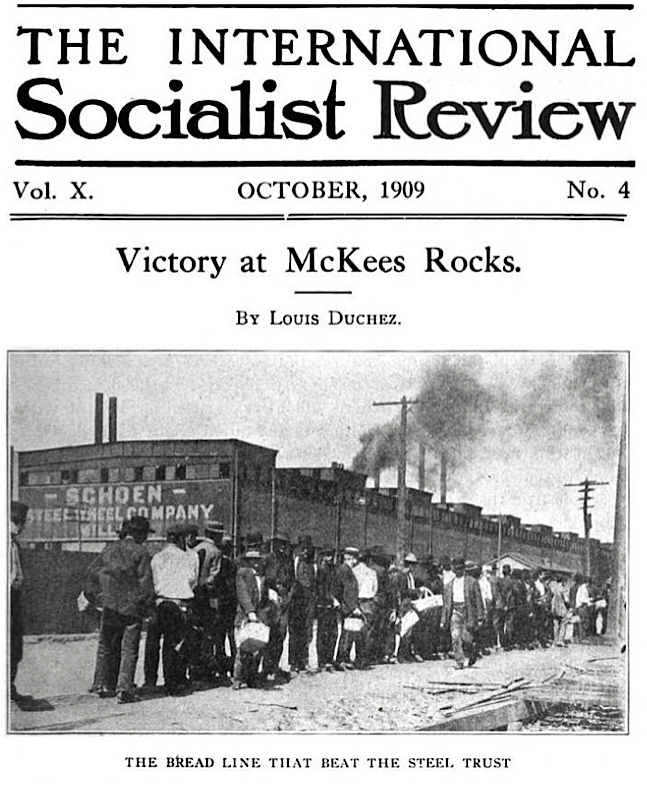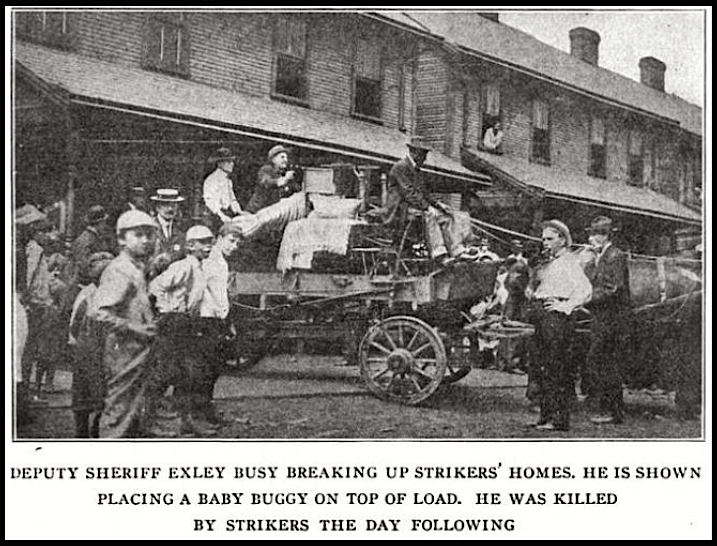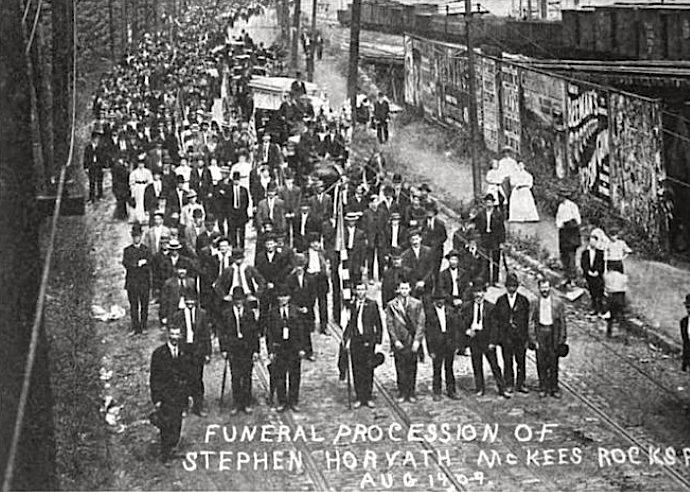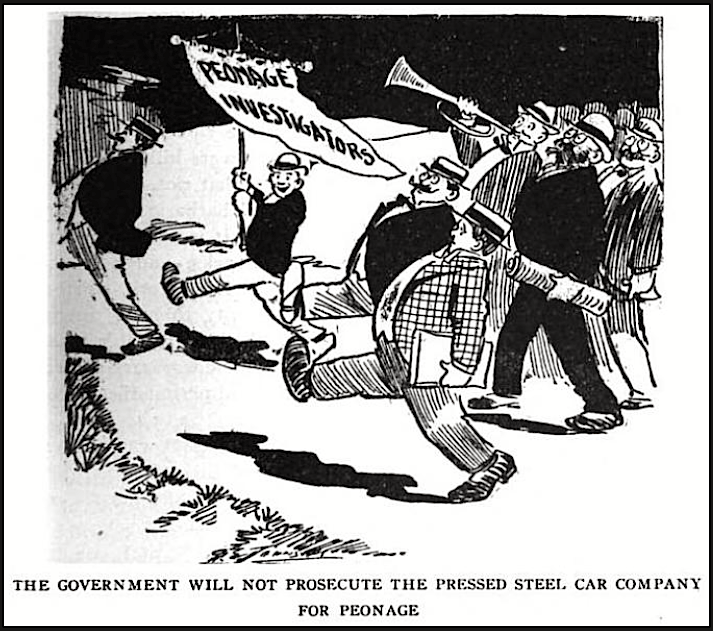 ———-
———-
Hellraisers Journal – Saturday October 9, 1909
Louis Duchez on Victory of McKees Rocks Strikers, Part I
From the International Socialist Review of October 1909:
[Part I of II.]
—–
N this article the writer is not going to give much space to a recitation of the crimes of the capitalist class at McKees Rocks and the other strike points in Pennsylvania. It is unnecessary. The capitalist press has done that more effectively—regardless of the motives that may have prompted them—than he is able to do. The class struggle is a historic fact and the diametrically opposed interests have long ago been proven. Such practices as were exposed during the last few weeks are only the logical result of the capitalist system of society at this stage of working class activity.
Readers of the Review want something more than a mere account of the cruelties of the Pressed Steel Car Company. They want to know something about the spirit and growth of solidarity and industrial organization among the striking wage slaves in Pennsylvania.
For the strike at McKees Rocks has been won. In spite of the tremendous odds against the men they have conquered in this battle against the Steel Trust. Not long ago we read in the papers that not one striker would be taken back at the mills. But they have been taken back. The pooling system has been abolished. They have gained a 5 per cent, increase in wages with an additional 10 per cent, within 60 days. Half-holiday Saturdays and no Sunday work. Grafting bosses have been “fired” along with all scabs. The shop rules have been revolutionized and the changed conditions afford employment for 1,000 more men. Most important of all, the workers have already built up during the struggle a revolutionary union of over 4,000 members, who thoroughly understand there will be no written agreement with the company and that a recognition of the union is not to be desired. Nor is this necessary. Craft lines have been obliterated and craft union organizers have been “passed up” with suspicion.
It is true that public sentiment was with the men, but it is also true that they have beaten the company in tactics at every point. And in writing up the account of the struggle, it is to this phase of the situation that the writer wishes to confine himself.
The strike began with, apparently, no organization among the men. Chaos seemed to prevail. Sixteen different nationalities were represented. Among them were: Americans, Germans, Hungarians, Ruthenians, Slavonians, Croatians, Polanders, Turks, Lithuanians, Russians, Greeks, Italians, Armenians, Roumanians, Bulgarians and Swiss. And the militant industrial unionists, who had training in the struggles in Europe—notably in Germany, Hungary and in the Russian revolution—played a very important part. Socialist leaders followed and established, with the aid of the industrial unionists, a remarkable discipline. Political propaganda, however, was useless among these men, because the fight was an industrial fight, and four-fifths of the strikers were not enfranchised anyway. Their shop minds could not get away from the mill—they wanted shop action.
A committee was elected known as the Big Six, only two of whom were revolutionists. The others were “pure and simplers.” These men ran the commissary store house, warned the men against violence and helped conduct the big meetings on Indian Mound. But so far as a knowledge of revolutionary tactics in a struggle of that kind was concerned, they knew nothing, although their intentions were of the best.
At the beginning of the strike, because of the many different nationalities, with nobody to bring them into a mutual understanding, there was much confusion. But a few men, who had been industrial unionists in Europe, got together, elected a committee among their own number and quietly, and without credit, planned the system and tactics of battle, put into operation methods of warfare, new in the history of labor wars in the United States.
Too much credit cannot be given these men, who went about forming an I. W. W. organization among the strikers. And the strikers found they had those among their own ranks who thoroughly understood the class struggle and up-to-date tactics in industrial unionism. But they were unable to make themselves understood.
This phase of the difficulty was overcome by securing interpreters and speakers and throwing the power and experience of the I. W. W. into the struggle. It is well to note in this connection, also, that four members of the Big Six committee represented only 1,000 of the strikers, while the two revolutionists on the committee represented nearly 5,000 men.
When it was learned that the controlling element of the Big Six was, consciously or unconsciously, reactionary and seemed to be at sea in dealing with the situation, an Unknown Committee acted in all cases of emergency. It was this committee that established the picket system, the signal system and the watch system which was so effective in keeping scabs out a few weeks ago. Among the foreigners this committee was known as the “Kerntruppen,” a term much in vogue in the military system of Germany. It means a choice group of fearless and trained men who may be trusted on any occasion.
This committee issued orders to the Cossacks in black and white, it is reported, after the killing of Horvath, one of their number, on August 12th, stating that for every striker killed or injured, a trooper would go. And they meant what they said, as is proved by the death of Deputy Sheriff Harry Exley and two troopers who went down in a riot on August 22nd with several strike breakers and some of the strikers, also.
It is also reported that the strikers could have killed every trooper if they had so desired, but they only resisted the violence meted out to them. The papers say the strikers and troopers are now on good terms and it is probable that no more rioting will occur. This Unknown Committee and the troopers know why. There has been an “understanding” between them that is more “sacred” than a contract between capital and labor by a long way.
On August 29th, a report was circulated that the bodies of three imported strike breakers, who died as a result of rotten food and brutal treatment, were cremated in one of the furnaces. Nobody doubts that they were cremated. Perhaps several poor workmen were gotten rid of in the same manner. When it is known that the dry bones of three foreigners were found under scrap heaps where they had lain for months in this same plant, it is easy to believe almost anything that may be told of that hell which is well-named “The Slaughter House.”
While still unproved, it is believed that the three bodies, cremated August 29th, were those of men who had been thrown alive into a hot furnace.
The Unknown Committee know how sixty strikers volunteered to hire out as strike breakers and go into the plant in order to get the scabs out. This was done. These sixty men were in the plant on the night the three foreigners were cremated. This much is known. But in the scrimmage, quick action was necessary and several went in who did not leave their names and were unknown outside their own friends.
At this writing the government is carrying on an investigation of this case, but there is no doubt in the minds of those who have been in close touch with events from the beginning, that the three cremated foreigners were three of the sixty volunteers.
Lack of space forbids a full description of the class war carried on in this little corner of the country. The tactics employed by the strikers at McKees Rocks, it is true, would soil the lady-like sensibilities of John Mitchell and Sammy Gompers, who love to sing the song of “identity of interest.” But the men acted on a full recognition of the cold hard facts and right in line with the words of A. M. Stirton, when he said :
Whatever line of conduct advances the interests of the working class is right, and whatever line of conduct does not advance the interests of the working class is wrong.
But the tactics employed by the men at McKees Rocks were not of their own choosing. Those of the master class have been more bold and cruel than the workers have yet, collectively, been fearless enough to employ. The workers did what their knowledge of strike warfare and class warfare compelled them to do.
It was not the workers who started the riot on the night of August 22nd, when a large number of people were killed and wounded. The Pressed Steel Car Company started that riot. The methods employed by the company were so brutal and barbaric that even the capitalist papers of Pittsburg exposed them. It is commonly known that Deputy Sheriff Harry Exler, the Cossacks, and a bunch of wharf-rats and hoodlums from Pittsburg and New York, started the trouble. They wanted to make an opportunity to mow down the wage slaves of “Hunkeytown.” Every method conceivable was employed to open up this opportunity. It is unnecessary to repeat them. But the workers refused to stand by and permit themselves to be starved, clubbed and shot to death!
The capitalist press stated that President Hoffstot wanted to see a charge of dynamite placed under the Pressed Steel Car Works, his object being to throw the blame upon the strikers and get rid of the old, worn-out plant and erect a newer and improved one.
A few days ago, Frank Morrison, of the A. F. of L. made the statement (and his is the organization that refused to have anything to do with the strikers) that the McKees Rocks strikers were an ignorant lot of foreigners. This is wholly false. Since the I. W. W. organized them, we learn that a large number of the men have been revolutionists in Europe. Many of the Hungarians took part in the great railway strike of Hungary. Three men were in the “Bloody Sunday” carnage in St. Petersburg. Participants in the Switzerland railroad strikes were there and several Italians who took part in the great resistance strike of Italy. Also there were many Germans with cards from the “Metallarbeiter Verband” (Metal Workers’ Industrial Union) of Germany, Austria, Denmark and Sweden. Besides there were many members of the socialist parties of Europe, and others who are members of the socialist party of America.
During the fight these men were to be found in “the hollow” in some private house laying the plans of battle. We do not belittle the daily mass meetings on Indian Mound. They were very effective in keeping the workers together and informed in regard to the situation, even though they were sometimes addressed by men and women who had practically no knowledge of the labor movement and the real requirements of the McKees Rocks situation.
But the strikers wanted something besides advice to refrain from violence and to abide their time. They wanted to know ways best fitted to meet the shrewd and heartless schemes of the company, and these things could not be shouted from the hill-tops. But the Unknown Committee in the valley laid the plans. So we can see that these strikers are not the mob of men the A. F. of L. would have us believe.
At the beginning of the strike, it is true, they had no organization. But this was because they had had no plan of organization and nobody to do that work, a great work with the men divided by sixteen different tongues.
But the I. W. W. brought these men together. Militant men who were able to speak the different languages carried the message and the men were eager to accept it.
[Emphasis added.]
[To be continued.]
~~~~~~~~~~~~~~~~~~~~~~
SOURCES & IMAGES
Quote EVD to McKees Rocks Strikers, Aug 25,
-Butler PA Ctzn p1, Aug 26, 1909
https://www.newspapers.com/image/346605697/
The International Socialist Review, Volume 10
(Chicago, Illinois)
-July 1909-June 1910
C. H. Kerr & Company,
https://books.google.com/books?id=MVhIAAAAYAAJ
ISR: Oct 1909
“Victory at McKees Rocks” by Louis Duchez
https://play.google.com/books/reader?id=MVhIAAAAYAAJ&printsec=frontcover&pg=GBS.PA289
See also:
Tag: McKees Rocks Pressed Steel Car Strike of 1909
https://weneverforget.org/tag/mckees-rocks-pressed-steel-car-strike-of-1909/
WE NEVER FORGET: Striker Steve Horvat
Who Lost His Life August 12, 1909, Martyr of the McKees Rocks Strike
A.M. Stirton
https://en.wikipedia.org/wiki/A.M._Stirton
Frank Morrison
http://www.gompers.umd.edu/fnmorrison.htm
Bloody Sunday St Petersburg 1905
https://en.wikipedia.org/wiki/Bloody_Sunday_(1905)
~~~~~~~~~~~~~~~~~~~~~~~~~~~~~~~~~~~~~~~~~~~~~
There Is Power in a Union – John McCutcheon
Lyrics by Joe Hill




